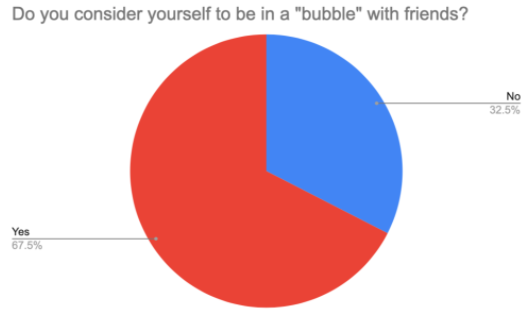Students explore creative ways to socialize in the midst COVID-19

A graph showing that 67.5% of students consider themselves inside a bubble. “Social bubbles” are easy ways to interact with a short list of friends during the pandemic.
October 22, 2020
At the beginning of this year, the social lives that WCHS students enjoyed were pretty normal. Students would see their friends on the weekends, after school and on days off. But on March 13, everything changed. The COVID-19 pandemic hit and teenagers were forced to make life-threatening decisions about their social lives.
WCHS students struggled through almost four months of quarantine, with no end in sight. However, at the end of summer break, Montgomery County moved to Phase two of its reopening plan. This allowed almost a complete reopening of activities, allowing a sense of normalcy among many students.
“Going into phase two was great because it allowed me to feel a lot more like normal,” said WCHS junior Jordan Sklar, “Things started to reopen and go back to what they were.”
For the first time during the pandemic, many Churchill students had a feeling that they didn’t have at any point during the pandemic: the freedom to see friends and resume their social lives.
However, the threat of a dangerous pandemic still exists and many Churchill students recognize the inherent risk associated with a return to normalcy before a slowdown in cases.
“It’s scary because reopening puts us in more danger, but it’s good to be able to do more,” said WCHS junior Kelsey Kwan.
Although the COVID-19 case numbers are down from 1784 new cases a day, daily case numbers have been slowly going up since moving into Phase Two (785 new cases on October 1).
The Observer polled 123 students with an anonymous survey and the results gave a rough estimate on how Churchill students were returning to normalcy in their social lives. It is clear that Churchill students are resuming in-person social interactions, with only 1.6% of surveyed students saying that they have not seen friends. In addition, 26% of students are seeing friends roughly once a week.
Throughout the pandemic, scientists have been urging groups to meet outside. It is clear that the respiratory droplets that cause COVID-19 have a harder time spreading with better air circulation.
Churchill students have been following these guidelines, with 41.5% of students saying that they primarily see friends outside without consistent masking or social distancing. Although this doesn’t fully reduce the chance of COVID-19 spread, staying outside will make it harder for virus particles to spread.
“Seeing friends outside gives me a sense of normalcy while still being safe,” said Sklar.
Many students incorporate CDC guidelines into their outside interactions. 40.6% of Churchill students report seeing friends outside with some combination of masking and social distancing. These activities can reduce the chance of COVID-19 spread.
The final way that Churchill students are socializing is inside, without CDC-recommended masks or social distancing. 16.3% of surveyed students report participating in this.
One of the most common ways that Churchill students have been socializing during the pandemic has been in “bubbles”. According to ABC News, a bubble is defined as “a middle-ground approach that expands social interaction and contains risk by limiting exposure.”
In practice, a bubble allows students to interact in a small, trusted group without COVID-19 precautions. Each member of the bubble agrees to exercise safe behavior, and only see each other. Churchill students have used the COVID-19 bubble in full force, with 67.5% of responses reporting that they are in a bubble with friends.
From the data, it is clear that Churchill students are finding unique ways to socialize during a pandemic. As a slow return to normalcy is achieved, students will need to be even more creative to safely return to their crowded social lives. However, one thing is for certain: social life during a pandemic is a daunting task that no students in modern history have had to experience.

